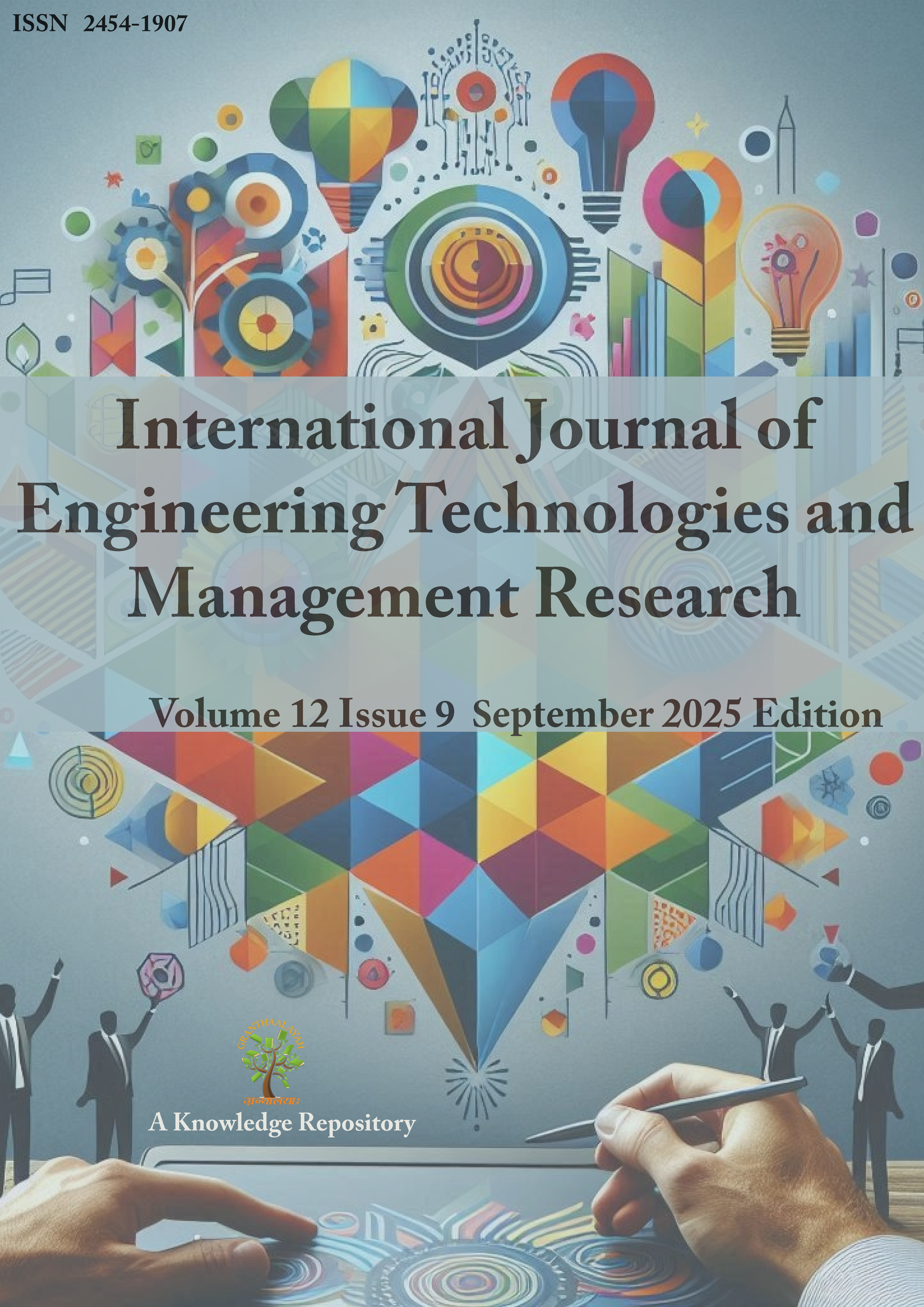STUDY OF SURFACE FINISH AS A FUNCTION OF CERAMIC TOOL WEAR WHEN TURNING HARDENED AISI 52100 STEEL
DOI:
https://doi.org/10.29121/ijetmr.v12.i9.2025.1668Keywords:
Turning Process, Ceramic Tools, Flank Wear, RoughnessAbstract
The turning process in hard materials has been way more used in the last few years because of the demand to reduce the manufacturing cost. This research analyzes the superficial roughness evolution in mixed ceramic tool`s wear used to turn ABNT 52100 hardened steel. This study has the objective to find the major reasons that influence the flank wear in ceramic insert and analyze how this wear influences the samples superficial roughness. In the turning process the variables cutting speed (Vc), feed (f) and machining depth (ap) were changed during the tests and analyzed their influences in superficial roughness. The experiments show that the greatest tool`s wear, for the variables used, was because of the forward speed. In the superficial finish study the only thing which has a great impact in average roughness (Ra) was the forward speed that when elevated has increased the average roughness. Meanwhile the vibration excess, caused by the machine`s low hardness, mainly for the several cutting properties, caused damages to the cutting tool that helped to increase the roughness rate while the flank wear also advanced.
Downloads
References
Abrão, A. M., Aspinwall, D. K., & Wise, M. L. H. (1995). Tool Wear, Cutting Forces and Temperature Evaluation When Turning Hardened Bearing Steel Using PCBN and Ceramic Materials. In Proceedings of the Thirty-First International Matador Conference (pp. 209–216). Manchester. https://doi.org/10.1007/978-1-349-13796-1_33 DOI: https://doi.org/10.1007/978-1-349-13796-1_33
Bartarya, G., & Choudhury, S. K. (2012). State of the Art in Turning. International Journal of Machine Tools and Manufacture, 53(1), 1–14. https://doi.org/10.1016/j.ijmachtools.2011.08.019 DOI: https://doi.org/10.1016/j.ijmachtools.2011.08.019
Binder, M., Klocke, F., & Doebbeler, B. (2017). An Advanced Numerical Approach on Tool Wear Simulation for Tool and Process Design in Metal Cutting. Simulation Modelling Practice and Theory, 70, 65–82. https://doi.org/10.1016/j.simpat.2016.09.001 DOI: https://doi.org/10.1016/j.simpat.2016.09.001
Diniz, A. E., Marcondes, F. C., & Coppini, N. L. (2014). Material Machining Technology (6th ed.). São Paulo: Artliber Publisher.
Grzesik, W. (2008). Influence of Tool Wear on Surface Roughness in Hard Turning Using Differently Shaped Ceramic Tools. Wear, 265(3–4), 327–335. https://doi.org/10.1016/j.wear.2007.11.001 DOI: https://doi.org/10.1016/j.wear.2007.11.001
He, C. L., Zong, W. J., & Zhang, J. J. (2018). Influencing Factors and Methods of Theoretical Modeling of Surface Roughness in the Turning Process: State of the Art. International Journal of Machine Tools and Manufacture, 129, 15–26. https://doi.org/10.1016/j.ijmachtools.2018.02.001 DOI: https://doi.org/10.1016/j.ijmachtools.2018.02.001
König, W., & Wand, T. H. (1988). Turning Bearing Steel with Amborite & Ceramic. Industrial Diamond Review, 47(3), 117–120.
Nakayama, K., Arai, M., & Kanda, T. (1988). Machining Characteristics of Hard Materials. Annals of the CIRP, 37(1), 89–92. https://doi.org/10.1016/S0007-8506(07)61592-3 DOI: https://doi.org/10.1016/S0007-8506(07)61592-3
Özel, T., Hsu, T., & Zeren, E. (2005). Effects of Cutting Edge Geometry, Workpiece Hardness, Feed Rate and Cutting Speed on Surface Roughness and Forces in Finish Turning of Hardened AISI H13 Steel. International Journal of Advanced Manufacturing Technology, 25(3–4), 262–269. https://doi.org/10.1007/s00170-003-1878-5 DOI: https://doi.org/10.1007/s00170-003-1878-5
Pavel, R., Marinescu, I., Deis, M., & Pillar, J. (2005). Effect of Tool Wear on Surface Finish for a Continuous and Interrupted Hard Turning Case. Journal of Materials Processing Technology, 170(1–2), 341–349. https://doi.org/10.1016/j.jmatprotec.2005.04.119 DOI: https://doi.org/10.1016/j.jmatprotec.2005.04.119
Sata, T. (1985). Analysis of Surface Roughness Generation in Turning Operation and its Applications. Annals of the CIRP, 34, 473–476. https://doi.org/10.1016/S0007-8506(07)61814-9 DOI: https://doi.org/10.1016/S0007-8506(07)61814-9
Singh, D., & Rao, P. V. (2007). A Surface Roughness Prediction Model for Hard Turning Process. International Journal of Advanced Manufacturing Technology, 32(11–12), 1115–1124. https://doi.org/10.1007/s00170-006-0429-2 DOI: https://doi.org/10.1007/s00170-006-0429-2
Thiele, J. D., & Melkote, S. N. (1999). Effect of Cutting Edge Geometry and Workpiece Hardness on Surface Generation in the Finish hard Turning of AISI 52100 Steel. Journal of Materials Processing Technology, 94(2–3), 216–226. https://doi.org/10.1016/S0924-0136(99)00111-9 DOI: https://doi.org/10.1016/S0924-0136(99)00111-9
Wins, K. L. D., & Varadarajan, A. S. (2011). An Environment Friendly twin-jet Minimal Fluid Application Scheme for Surface Milling of Hardened AISI 4340 Steel. International Journal of Manufacturing Systems, 30–45. https://doi.org/10.3923/ijmsaj.2011.30.45 DOI: https://doi.org/10.3923/ijmsaj.2011.30.45
Zhou, J. M., Andersson, M., & Ståhl, J. E. (2004). Identification of Cutting Errors in Precision Hard Turning Process. Journal of Materials Processing Technology, 153–154, 746–750. https://doi.org/10.1016/j.jmatprotec.2004.04.331 DOI: https://doi.org/10.1016/j.jmatprotec.2004.04.331
Published
How to Cite
Issue
Section
License
Copyright (c) 2025 Jean Carlo Cescon Pereira, Vinícius Chiaradia Pereira

This work is licensed under a Creative Commons Attribution 4.0 International License.
License and Copyright Agreement
In submitting the manuscript to the journal, the authors certify that:
- They are authorized by their co-authors to enter into these arrangements.
- The work described has not been formally published before, except in the form of an abstract or as part of a published lecture, review, thesis, or overlay journal.
- That it is not under consideration for publication elsewhere.
- That its release has been approved by all the author(s) and by the responsible authorities – tacitly or explicitly – of the institutes where the work has been carried out.
- They secure the right to reproduce any material that has already been published or copyrighted elsewhere.
- They agree to the following license and copyright agreement.
Copyright
Authors who publish with International Journal of Engineering Technologies and Management Research agree to the following terms:
- Authors retain copyright and grant the journal right of first publication with the work simultaneously licensed under a Creative Commons Attribution License (CC BY-SA 4.0) that allows others to share the work with an acknowledgment of the work's authorship and initial publication in this journal.
- Authors can enter into separate, additional contractual arrangements for the non-exclusive distribution of the journal's published version of the work (e.g., post it to an institutional repository or edit it in a book), with an acknowledgment of its initial publication in this journal.
- Authors are permitted and encouraged to post their work online (e.g., in institutional repositories or on their website) before and during the submission process, as it can lead to productive exchanges, as well as earlier and greater citation of published work.
For More info, please visit CopyRight Section





















